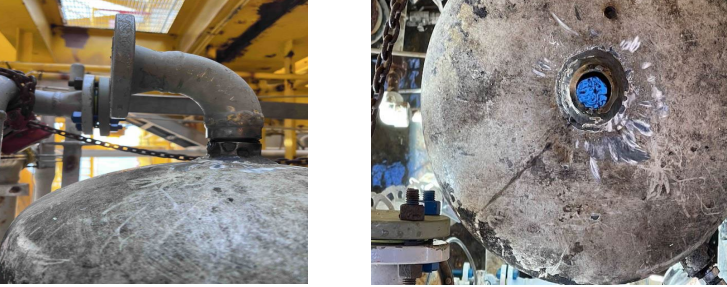The Bureau of Safety and Environmental Enforcement (BSEE) was recently notified of an incident that highlights the potential risk of flash fires in offshore industrial environments, which can often result in severe injuries or fatalities if proper safety precautions are not followed.
The incident occurred during a welding operation with a fit-up nozzle. As the welder was completing the first tack weld and commencing the second, vapors inside the tank ignited, triggering a flash fire and a subsequent blast that propelled the welder against a rail. The welder was properly tied off, so did not sustain injuries.

Incident Details:
Preparations preceding the incident involved cutting a nozzle off the top of a pressure vessel, with supervisor approval to proceed. After cutting and grinding the bevel, operations were paused until the necessary spool piece arrived. Once the spool| piece was received the following afternoon, cutting and beveling of the spool commenced. Initial readings indicated a 0% lower explosive limit (LEL) after cutting all nozzles off. Despite the installation of a new nozzle and the successful tacking of one side, the occurrence of the flash fire during the second tack weld underscores the importance of vigilance and thorough safety checks. Subsequent LEL sequence checks yielded readings ranging from 0 to 70%, emphasizing the unpredictable nature of these types of operations and the necessity for stringent safety protocols. Personnel outside the immediate area where the incident occurred, including those in the office, were startled by the blast. Subsequent checks confirmed the vessel was filled with water and equipped with the appropriate inlet and outlet skillets, ensuring its safety.
Hot work was being conducted on the fuel gas scrubber, with preliminary checks for LEL and water levels in the scrubber conducted prior to welding. However, during the welding process, an unexpected blowback of white smoke occurred. This indicated a sudden ignition event. The presence of water in the tank suggests that the flash fire might have been caused by residual flammable gases or vapors trapped in pockets within the vessel or in the scrubber system. The heat or sparks from the welding process ignited these gases, leading to the blowback and the resulting blast. This incident demonstrates the importance of thorough ventilation and gas detection processes, even in seemingly safe environments.
Contributing Causes for Flash Fire Include:
- The initial successful tack weld likely disturbed the vapors inside the tank, setting off the ignition when the second tack weld was attempted.
- Despite being properly tied off, the blast from the ignited vapors propelled the welder against the rail, indicating inadequate safety precautions or insufficient distance from the potential hazard zone.
- Although the LEL was initially checked and found to be 0%, after cutting and grinding the bevel, subsequent checks revealed LEL readings ranging from 0 to 70%. This discrepancy suggests a failure to adequately assess and monitor the presence of flammable vapors.
- The occurrence of blowback with white smoke during the welding process suggests a potential flaw in the welding procedure or technique, which may have contributed to the ignition of vapors or other safety hazards.
BSEE recommends that operators and their contractors, where appropriate, consider doing the following:
- Conduct thorough checks for potential hazards prior to any welding or hot work activity, including vapor presence and explosive limits. Verify the integrity of equipment such as fuel gas scrubbers and vessels to ensure they are properly sealed and filled with inert substances like water.
- Establish clear protocols for performing hot work, including welding, cutting, and grinding. This should include obtaining appropriate permissions and conducting necessary safety assessments, such as checking for flammable vapors and ensuring adequate ventilation.
- Improve communication between workers involved in hot work activities. Ensure everyone understands their roles and responsibilities, including the need for continuous monitoring and coordination during critical tasks like nozzle fitting and welding.
- Ensure all personnel involved in hot work activities receive comprehensive training on safety procedures, hazard recognition, and emergency response
protocols. This should include specific training on handling flammable substances and recognizing signs of potential ignition. - Increase supervision during critical phases of hot work, such as nozzle fitting and initial tack welding. Supervisors should monitor work progress closely and intervene if any deviations from safety protocols are observed.
- Implement engineering controls to minimize the risk of flash fires, such as installing flame arrestors or inert gas purging systems in areas where hot work is conducted on potentially flammable equipment.
- Ensure that all workers involved in hot work activities are equipped with appropriate personnel protective equipment. This includes flame-resistant
clothing, welding helmets with appropriate shades, and proper fall protection to mitigate the impact of any potential flash fires. - Schedule periodic safety audits and reviews to identify potential gaps in safety procedures and address any shortcomings. Encourage a culture of continuous improvement by soliciting feedback from workers and incorporating lessons learned from past incidents into safety protocols.

































































